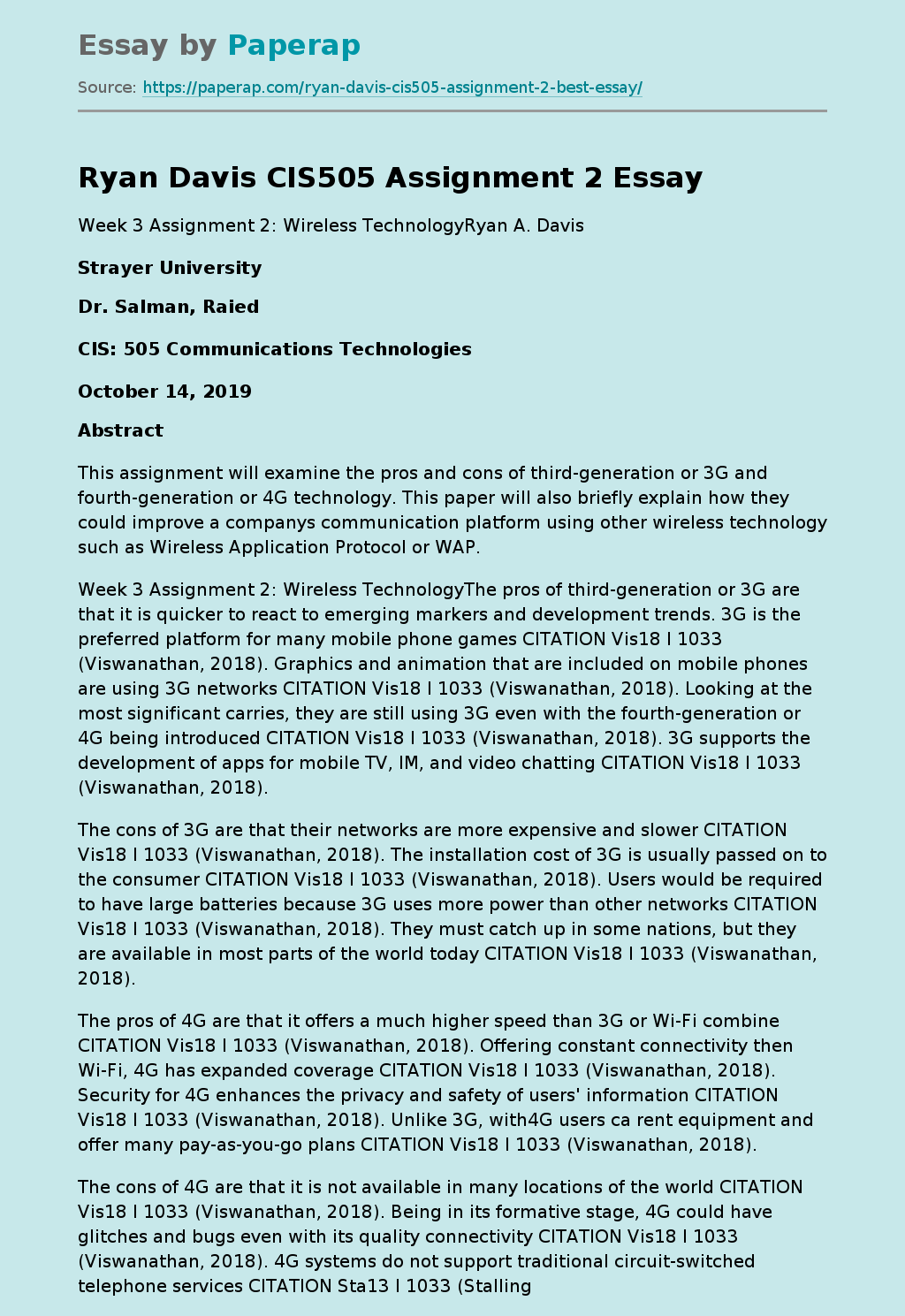Ryan Davis CIS505 Assignment 2
Week 3 Assignment 2: Wireless TechnologyRyan A. Davis
Strayer University
Dr. Salman, Raied
CIS: 505 Communications Technologies
October 14, 2019
Abstract
This assignment will examine the pros and cons of third-generation or 3G and fourth-generation or 4G technology. This paper will also briefly explain how they could improve a companys communication platform using other wireless technology such as Wireless Application Protocol or WAP.
Week 3 Assignment 2: Wireless TechnologyThe pros of third-generation or 3G are that it is quicker to react to emerging markers and development trends.
3G is the preferred platform for many mobile phone games CITATION Vis18 l 1033 (Viswanathan, 2018).
Graphics and animation that are included on mobile phones are using 3G networks CITATION Vis18 l 1033 (Viswanathan, 2018). Looking at the most significant carries, they are still using 3G even with the fourth-generation or 4G being introduced CITATION Vis18 l 1033 (Viswanathan, 2018). 3G supports the development of apps for mobile TV, IM, and video chatting CITATION Vis18 l 1033 (Viswanathan, 2018).
The cons of 3G are that their networks are more expensive and slower CITATION Vis18 l 1033 (Viswanathan, 2018). The installation cost of 3G is usually passed on to the consumer CITATION Vis18 l 1033 (Viswanathan, 2018). Users would be required to have large batteries because 3G uses more power than other networks CITATION Vis18 l 1033 (Viswanathan, 2018). They must catch up in some nations, but they are available in most parts of the world today CITATION Vis18 l 1033 (Viswanathan, 2018).
The pros of 4G are that it offers a much higher speed than 3G or Wi-Fi combine CITATION Vis18 l 1033 (Viswanathan, 2018). Offering constant connectivity then Wi-Fi, 4G has expanded coverage CITATION Vis18 l 1033 (Viswanathan, 2018). Security for 4G enhances the privacy and safety of users’ information CITATION Vis18 l 1033 (Viswanathan, 2018). Unlike 3G, with4G users ca rent equipment and offer many pay-as-you-go plans CITATION Vis18 l 1033 (Viswanathan, 2018).
The cons of 4G are that it is not available in many locations of the world CITATION Vis18 l 1033 (Viswanathan, 2018). Being in its formative stage, 4G could have glitches and bugs even with its quality connectivity CITATION Vis18 l 1033 (Viswanathan, 2018). 4G systems do not support traditional circuit-switched telephone services CITATION Sta13 l 1033 (Stallings & Case, 2013). Since users will have to purchase modems or rent them, it will cause many users not to use it CITATION Vis18 l 1033 (Viswanathan, 2018). Once the fifth-generation or 5G is introduced, 4G will not be as popular.
Third-generation (3G), fourth-generation (4G), Wireless Wide Area Network (WWAN), and Worldwide Interoperability for Microwave Access (WiMAX) are wireless technology methods that give businesses and organizations an advantage for increasing communications. Business and organizations that authorize employees to work mobile, they likely use 3G networks for interconnectivity. When a company has multiple work locations, it will typically consider using WWAN. Using WWAN, they will have an interconnection of the different locations using satellite transmissions.
When a company decides to use 4G, they use it because of its broader coverage and the fact that it has better security CITATION Vis18 l 1033 (Viswanathan, 2018). Using WiMAX, a company would save money. They would save money because it is less expensive, but it may have a range of up to 30 miles for voice and data service connection.
One change of 4G technology since 2009 was the introduction of Long-term Evolution Advanced (LTE-A). LTE-A offers faster speeds and more excellent stability than the normal Long-term Evolution (LTE) CITATION 4Gv19 l 1033 (Hill, 2019). Using LTE-A, organizations, and businesses can download data from multiple sources at the same time CITATION 4Gv19 l 1033 (Hill, 2019). Carries are starting to test the fifth-generation or 5G, but the infrastructure will take some time as well as the money to build it CITATION 4Gv19 l 1033 (Hill, 2019).
Wireless Application Protocol or WAP is a universal, open standard developed by the WAP Forum to provide mobile users to access technology and information services, including the Internet and the Web CITATION Sta13 l 1033 (Stallings & Case, 2013). The WAP Forum was developed in 1997, and it was developed to address the limitations of cellular and other wireless networks CITATION Sta13 l 1033 (Stallings & Case, 2013). I believe that WAP is a necessity for wireless communications organizations and their users. WAP unifies wireless standards, and it was designed to work with all wireless network technologies CITATION Sta13 l 1033 (Stallings & Case, 2013). Organizations benefit from WAP because it allows their customers many applications and content that is available on the Internet CITATION Smi19 l 1033 (Smith, 2019). End-users benefit from WAP because they can access any web content through HTML-to-WML services CITATION Smi19 l 1033 (Smith, 2019)References
BIBLIOGRAPHY Dussad, V. (2010, January 12). Importance and benefits of WAP. Retrieved from India Study Channel:
Hill, S. (2019, July 17). 4G vs. LTE: The differences explained. Retrieved from Digital Trends:
Smith, B. (2019, May 1). Advantages and Disadvantages of 3G Internet Technology Compared To 2G. Retrieved from Internet Access Guide:
Stallings, W., & Case, T. (2013). Standards Research. In W. Stallings, & T. Case, Business Data Communications: Infrastructure, Networking, and Security 7th Edition (p. 493). Upper Saddle River: Pearson.
Viswanathan, P. (2018, December 3). 3G Vs. 4G – Which is Better? Retrieved from Lifewire:
Ryan Davis CIS505 Assignment 2. (2019, Nov 23). Retrieved from https://paperap.com/ryan-davis-cis505-assignment-2-best-essay/

